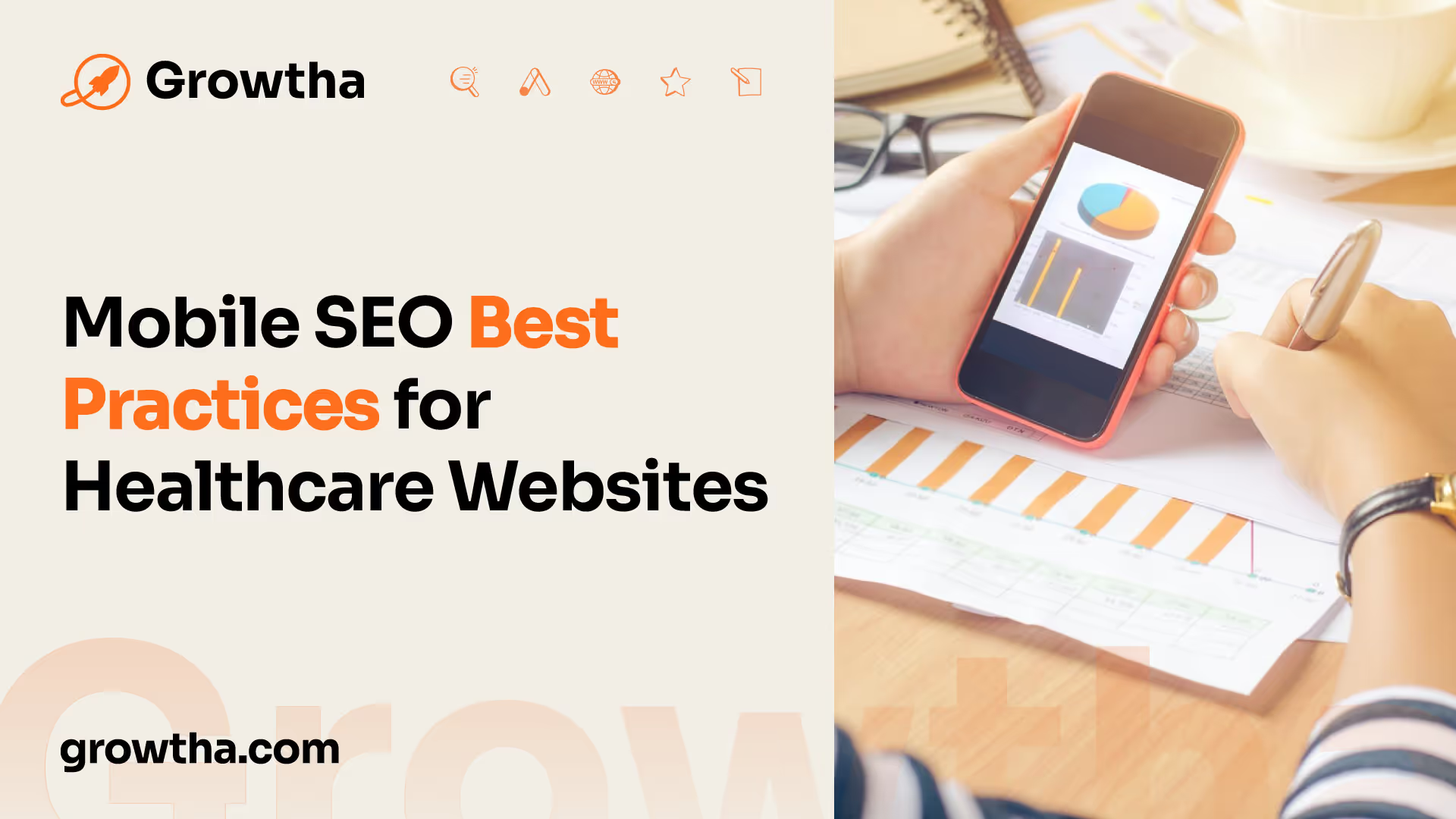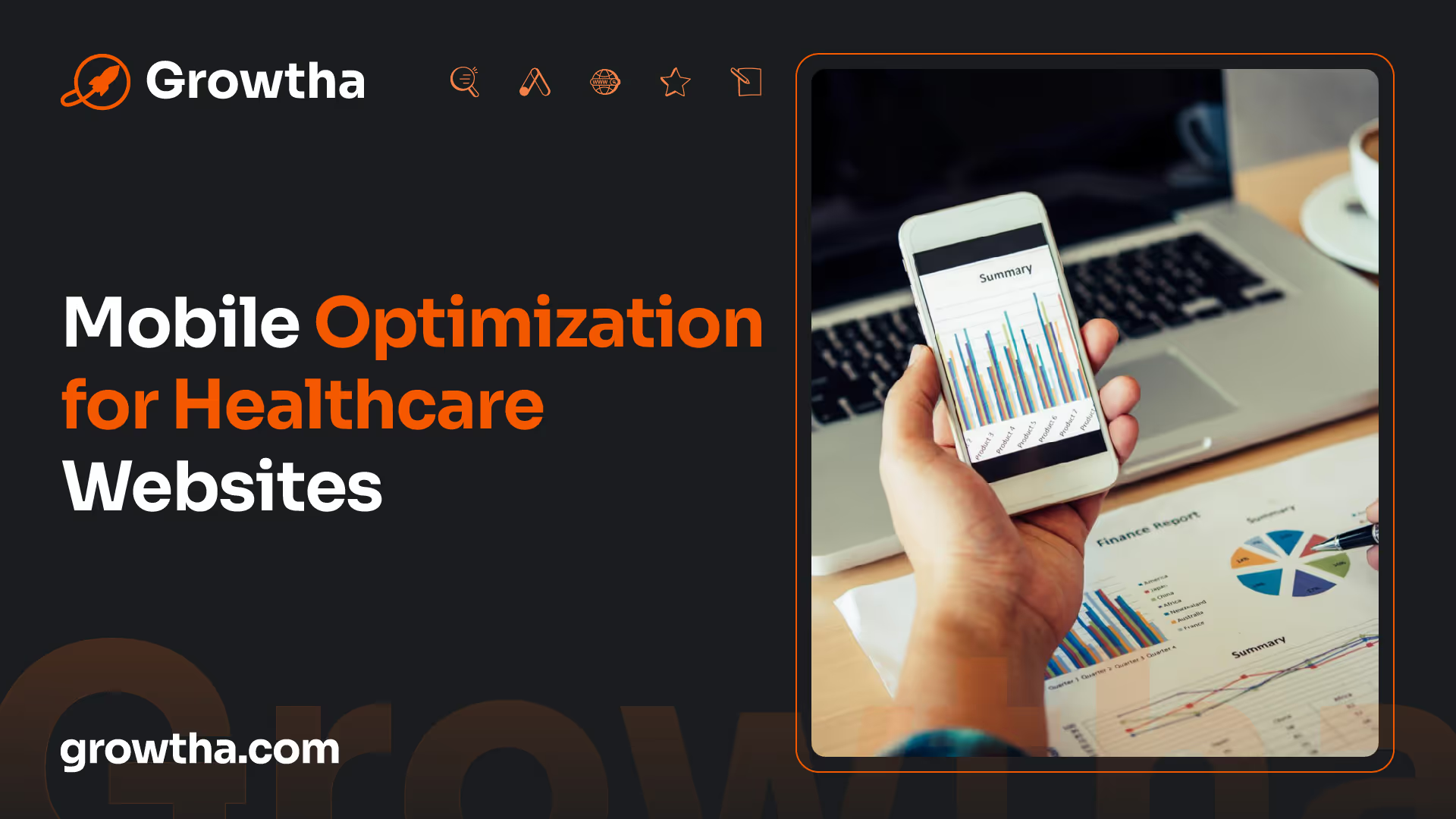Mobile SEO Best Practices for Healthcare Websites
Implementing effective search engine optimization (SEO) strategies is especially important to ensure that healthcare websites are easily discoverable and accessible to patients.


Mobile SEO Best Practices for Healthcare Websites
Importance of Healthcare SEO
In the digital age, having a strong online presence is crucial for healthcare providers. Implementing effective search engine optimization (SEO) strategies is especially important to ensure that healthcare websites are easily discoverable and accessible to patients. Let's explore the benefits of SEO in healthcare and some relevant statistics to understand its significance.
Benefits of SEO in Healthcare
Utilizing SEO techniques in healthcare marketing offers several key benefits. Firstly, it helps improve the visibility of healthcare websites in search engine results, making it easier for patients to find relevant information and services. Higher visibility can lead to increased website traffic, which in turn can translate into more patient inquiries and appointments.
Moreover, SEO enables healthcare providers to establish their authority and credibility in the industry. By optimizing their websites with valuable and informative content, healthcare organizations can position themselves as trusted sources of information. This can enhance patient trust, foster loyalty, and ultimately drive patient engagement.
Another advantage of SEO in healthcare is the ability to target specific audiences. By optimizing the website's content, structure, and keywords, healthcare providers can attract patients who are actively searching for their services. This targeted approach can yield higher-quality leads and a better return on investment.
Healthcare SEO Statistics
Several statistics highlight the importance of SEO in the healthcare industry:
- Approximately 60% of American consumers use online scheduling tools to make healthcare appointments [1]. This emphasizes the significance of having a strong online presence to facilitate patient engagement and appointment booking.
- Nearly 90% of patients turn to search engines, such as Google, to research their symptoms before visiting a healthcare professional [1]. This demonstrates the need for healthcare providers to have relevant and trustworthy content available to address patient concerns and establish themselves as reliable sources of information.
- Content marketing, which is closely tied to SEO, costs 62% less than traditional marketing strategies while generating three times as many leads [1]. This highlights the cost-effectiveness and effectiveness of content-driven SEO approaches in attracting and engaging patients.
- Google reports that online searches drive three times as many visitors to hospital websites compared to other sources. This further emphasizes the importance of optimizing healthcare websites to rank higher in search engine results and capture organic traffic.
- A significant 80% of US adults conducted a healthcare-related search in the last year. This statistic underscores the prevalence of online health-related searches and the need for healthcare providers to optimize their websites to meet the information needs of potential patients.
These statistics indicate that healthcare SEO is a critical component of any healthcare marketing strategy. By implementing effective SEO practices, healthcare providers can enhance their online visibility, connect with patients, and drive meaningful engagement.

Mobile Optimization for Healthcare Websites
In today's digital landscape, mobile optimization is crucial for healthcare websites. With over 50% of website traffic coming from mobile devices, it's imperative to ensure that your healthcare website is optimized for mobile use. This section will explore the impact of mobile SEO and provide best practices for optimizing healthcare websites for mobile devices.
Impact of Mobile SEO
Mobile optimization has a significant impact on healthcare websites, offering various benefits for both patients and healthcare providers. Here are some key points to consider:
- Improved User Experience: Mobile-friendly websites provide a seamless and user-friendly experience for visitors accessing your site on smartphones and tablets. Responsive design and optimized navigation enhance usability and make it easier for patients to find the information they need.
- Accessibility: Mobile optimization ensures that your healthcare website can be accessed by a wider audience, regardless of the device they are using. This inclusivity is especially important in the healthcare industry, where patients may need to access medical information or book appointments on the go.
- Search Rankings: Search engines prioritize mobile-friendly websites in their rankings. By optimizing your healthcare website for mobile devices, you increase the chances of appearing higher in search results, driving more organic traffic to your site.
- Patient Engagement: A mobile-friendly website can enhance patient engagement by providing convenient access to medical resources, appointment scheduling, patient portals, and telemedicine services. This accessibility encourages patients to actively engage with your healthcare services.
Mobile SEO Best Practices
To optimize your healthcare website for mobile devices, here are some best practices to follow:
- Responsive Design: Implement a responsive design that automatically adapts your website layout to fit different screen sizes. This ensures a consistent user experience across various mobile devices.
- Quick Loading Times: Optimize your website's loading speed to provide a seamless browsing experience for mobile users. Studies have shown that a slow-loading website can lead to visitor abandonment and decreased conversion rates. Aim for a loading speed of three seconds or less to keep patients engaged [3].
- Mobile-Friendly Navigation: Simplify navigation for mobile users by implementing clear menus, easy-to-access contact information, and intuitive search functionality. Make sure that buttons and links are large enough to be easily tapped on touchscreen devices.
- Clear and Readable Content: Ensure that your website's content is easily readable on smaller screens. Use legible font sizes, clear headings, and sufficient spacing between paragraphs. Consider using bullet points or numbered lists to enhance readability.
- Optimize Images: Compress images to reduce file sizes without compromising quality. Large image files can slow down website loading times, negatively impacting the user experience.
- Test Across Devices: Test your website's responsiveness and functionality on various mobile devices, including smartphones and tablets. This ensures that the user experience remains consistent across different screen sizes and operating systems.
By adhering to these mobile SEO best practices, healthcare websites can enhance user experience, improve search rankings, and ultimately drive more patient engagement. Remember to regularly review and update your mobile optimization strategies to stay ahead in the ever-evolving digital landscape.

Content Marketing for Healthcare SEO
When it comes to healthcare SEO, content marketing plays a vital role in driving organic traffic and improving search engine rankings. High-quality content not only provides valuable information to users but also helps healthcare websites establish themselves as industry leaders. Let's explore the role of content in SEO and some effective content strategies for healthcare.
Role of Content in SEO
Content is the backbone of any successful SEO strategy. It serves as the foundation for optimizing a website's visibility on search engines. High-quality, relevant, and informative content is crucial in attracting and engaging users, encouraging them to spend more time on the website. This increased engagement signals to search engines that the website is valuable and authoritative, leading to higher rankings in search results [2].
Creating original and freely distributed resources on healthcare websites, such as patient portals, online bill payments, appointment scheduling, and newsletters, can further enhance the user experience. These resources not only provide convenience to patients but also establish the healthcare provider as a trusted source of information, leading to organic word-of-mouth growth [4].
Content Strategies for Healthcare
To optimize healthcare websites for search engines, it's important to develop content strategies that focus on relevant medical keywords and provide accurate, up-to-date information. By incorporating targeted keywords into the content, healthcare websites can improve their search engine visibility and attract more organic traffic. Some effective content strategies include:
- Long-Tail Keywords: Long-tail keywords are specific phrases that target a niche audience. Using long-tail keywords related to healthcare services, treatments, or conditions can help healthcare websites rank higher in search results and reach users who are actively seeking specialized information.
- Location-Based Keywords: For healthcare providers targeting a specific geographic area, incorporating location-based keywords can help attract local patients. Including the name of the city or region in the content, titles, and meta descriptions can enhance search engine visibility for local searches.
- Keyword-Rich Titles and Descriptions: Optimizing titles and meta descriptions with relevant keywords is essential for SEO. These elements appear in search engine results and can significantly impact click-through rates. By including keyword-rich titles and descriptions, healthcare websites can increase their chances of attracting organic traffic.
- Expertise, Authority, and Trust (E-A-T): Following Google's E-A-T algorithm, healthcare websites should focus on demonstrating expertise, authority, and trustworthiness through their content. This can be achieved by providing accurate medical information, citing reputable sources, and showcasing the credentials and expertise of healthcare professionals.
By implementing these content strategies, healthcare websites can improve their visibility in search engine results and provide valuable information to users. Remember to regularly update and optimize content to stay relevant and maintain a strong online presence.
Technical Aspects of Healthcare SEO
When it comes to healthcare SEO, paying attention to the technical aspects of your website is crucial for improving its visibility and ranking on search engines. In this section, we will explore two important technical aspects: on-page optimization and crawlability and indexing.
On-Page Optimization
On-page optimization refers to optimizing the elements on individual web pages to improve their visibility in search engine results. By strategically optimizing various on-page elements, healthcare websites can enhance search engine understanding and user experience.
Here are some key on-page optimization practices to consider for healthcare SEO:
- Title Tags: Craft descriptive and keyword-rich title tags that accurately represent the content of each page. Include relevant keywords near the beginning of the title tag to improve search engine visibility.
- Meta Descriptions: Write compelling meta descriptions that summarize the page's content and encourage users to click through. While meta descriptions don't directly impact rankings, they play a crucial role in attracting organic traffic.
- Headers: Utilize header tags (H1, H2, H3, etc.) to structure your content and make it more readable for both search engines and users. Incorporate relevant keywords in your headers to signal the page's relevance to search engines.
- URL Structures: Create clean and user-friendly URLs that include relevant keywords. Avoid long, complex URLs and use hyphens to separate words.
- Internal Linking: Incorporate internal links within your website's content to establish connections between related pages. Internal linking helps search engines understand the structure of your website and improves user navigation.
- Navigation Experience: Ensure a seamless navigation experience by making your website's menu intuitive and user-friendly. A clear navigation structure helps visitors find the information they need quickly and easily.
By implementing these on-page optimization techniques, healthcare websites can improve their visibility to search engines and provide a better user experience to their visitors.
Crawlability and Indexing
Crawlability is a critical factor in determining how well a healthcare website ranks in search engine results. It refers to the ability of search engine crawlers to find and access your website's pages. To ensure optimal crawlability and indexing, consider the following best practices:
- XML Sitemap: Create an XML sitemap that lists all the pages on your website. Submit this sitemap to search engines to help them discover and index your pages more efficiently.
- Robots.txt: Use a robots.txt file to instruct search engine crawlers on which pages to crawl and which to exclude. This file helps you control the indexing process and prevent search engines from accessing sensitive or duplicate content.
- Page Speed: Optimize your website's loading speed to enhance the user experience and improve crawlability. A slow-loading website can negatively impact both user engagement and search engine rankings. Aim for a loading speed of three seconds or less, as recommended by most medical SEO experts [3].
- Original Content: Produce original and unique content for your healthcare website to avoid duplicate content issues. While drawing inspiration from others is acceptable, copying someone else's content can lead to penalties from search engines like Google [3].
By focusing on crawlability and indexing, healthcare websites can ensure that search engine crawlers can efficiently access and index their content, leading to improved visibility and higher rankings in search engine results.
Local SEO for Healthcare Providers
When it comes to healthcare marketing, local SEO plays a vital role in connecting healthcare providers with their target audience. Many patients search for healthcare providers using location-specific terms, making local search an important aspect of healthcare SEO [2]. By implementing effective local SEO strategies, healthcare organizations can tap into highly relevant, local searches from potential patients looking for services in their area.
Importance of Local Search
Local SEO is crucial for healthcare organizations to effectively target the right audience. By optimizing their Google My Business listing, ensuring consistency in practice information across online directories, and encouraging positive patient reviews, healthcare providers can increase their visibility in local search results. Additionally, local citations from reliable healthcare directories enhance their presence in local searches [7].
The importance of local search can be seen in the increased relevance and specificity of search results. When potential patients search for healthcare services, they often include location-specific terms such as city or neighborhood names. By optimizing their website and content for local search, healthcare providers can enhance their visibility and attract patients searching for services in their area.
Local SEO Strategies
To effectively implement local SEO for healthcare providers, there are several strategies to consider. These strategies focus on optimizing various aspects of online presence to improve local search rankings:
- Optimize Google My Business: Creating and optimizing a Google My Business profile is essential. Ensure that your profile is complete, accurate, and up to date. Include important information such as address, phone number, business hours, and services offered. Encourage patients to leave reviews on your Google My Business listing to build credibility and attract more local traffic.
- Consistency in Practice Information: Consistency is key when it comes to practice information across online directories. Ensure that your name, address, and phone number (NAP) details are consistent across all directories, including your website, social media profiles, and healthcare-specific directories.
- Positive Patient Reviews: Encourage your patients to leave positive reviews on platforms like Google, Yelp, and healthcare-specific review sites. Positive reviews not only help improve your online reputation but also boost your visibility in local search results.
- Local Citations: Get listed on reliable healthcare directories and local business directories. These citations provide search engines with consistent and trustworthy information about your practice and help improve your local search rankings.
By implementing these local SEO strategies, healthcare providers can increase their visibility in local search results, attract local patients, and establish a strong online presence within their community.
Effective healthcare SEO involves a comprehensive approach that encompasses not only local SEO but also other aspects such as mobile optimization, content marketing, and technical optimization. By understanding patient personas, tailoring strategies to target their specific interests, and following best practices, healthcare organizations can enhance their online presence, reach their target audience, and drive more traffic to their websites.
Healthcare SEO Strategies
To achieve success in healthcare SEO, implementing effective tactics and continuously improving your strategies are essential. By employing these strategies, healthcare providers can enhance their online presence, attract relevant leads, and build trust with potential patients.
Effective SEO Tactics
- Quality Content: Producing high-quality, informative, and engaging content is a fundamental aspect of healthcare SEO. By providing valuable information and answering common questions, healthcare websites can establish themselves as authoritative sources in their respective fields. This can lead to increased visibility, improved search engine rankings, and a positive impact on patient trust and loyalty.
- Crawlability and Indexing: Ensuring that search engines can crawl and index your website is crucial for visibility in search results. Optimize your website's structure, navigation, and internal linking to facilitate easy crawling by search engine bots. Implementing a sitemap and submitting it to search engines can also help improve your website's crawlability and indexing.
- Monitoring SEO Progress: Regularly monitoring and analyzing your SEO performance is essential for identifying areas of improvement. Utilize tools like Google Analytics and Google Search Console to track key metrics such as organic traffic, keyword rankings, and user behavior. This data can provide insights into the effectiveness of your SEO efforts and guide your future strategies.
- Building Website Authority: Building website authority through backlinks is an effective tactic to improve your search engine rankings. Seek opportunities to earn high-quality backlinks from reputable sources within the healthcare industry. This can be achieved through guest blogging, collaborations, and participation in industry events.
Continuous SEO Improvement
- Patient Experience Optimization: Prioritizing the patient experience on your website is crucial for healthcare SEO. Ensure that your website is user-friendly, easy to navigate, and provides a seamless browsing experience across different devices. Optimize page load speed, implement responsive design, and make information easily accessible to enhance user satisfaction and engagement.
- EAT Requirements: Prioritize EAT requirements, which stand for expertise, authoritativeness, and trustworthiness. Establish credibility by showcasing the expertise of your healthcare professionals, highlighting their qualifications, certifications, and relevant experience. Leverage patient testimonials and positive online reviews to build trust with search engines and potential patients.
- Local SEO with Google My Business: Local SEO is particularly important for healthcare providers targeting a specific geographical area. Claim and optimize your Google My Business profile to improve your visibility in local search results. Provide accurate and up-to-date information about your practice, including your address, phone number, and operating hours. Encourage patients to leave reviews, as positive online reviews can significantly benefit healthcare businesses.
- Mobile Usability and Site Speed: Optimizing your website for mobile usability and site speed is crucial in today's mobile-first world. Ensure that your website is responsive and provides a seamless browsing experience on mobile devices. Optimize images, minimize server response time, and leverage caching techniques to improve site speed. A fast-loading and mobile-friendly website not only enhances user experience but also positively impacts your search engine rankings.
By implementing these effective SEO tactics and continuously improving your strategies, healthcare providers can enhance their online presence, attract relevant traffic, and establish themselves as authoritative sources in the healthcare industry. Keep in mind the unique needs and challenges of your target audience and adapt your strategies accordingly to achieve optimal results.
References
[1]: https://kanopi.com/blog/healthcare-content-marketing/
[2]: https://www.siteimprove.com/glossary/healthcare-seo/
[3]: https://digitalismedical.com/blog/seo-for-medical-practices/
[4]: https://www.sagefrog.com/blog/5-common-mistakes-healthcare-website-mistakes-avoid/
[5]: https://www.demandhub.co/articles/healthcare-marketing-strategies/
[6]: https://comradeweb.com/blog/medical-seo-tips-to-improve-seo-for-medical-websites/
[7]: https://www.linkedin.com/pulse/fundamentals-healthcare-seo-9-tips-organic-growth-paul-slaney?trk=pulse-article







